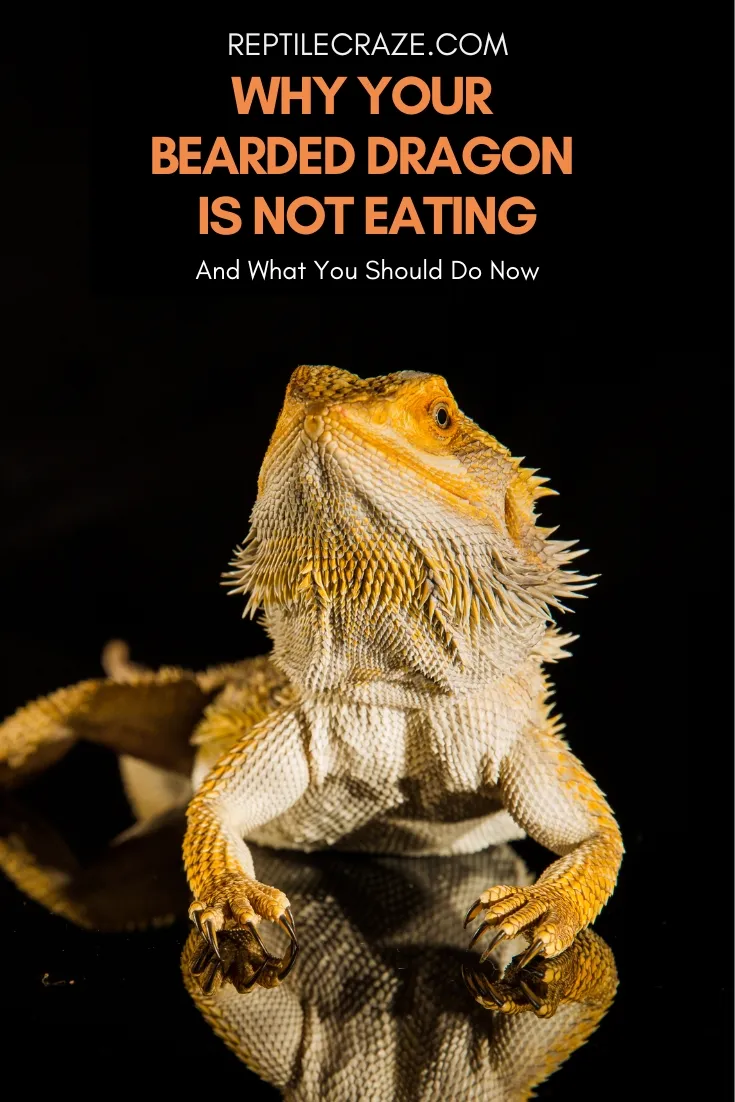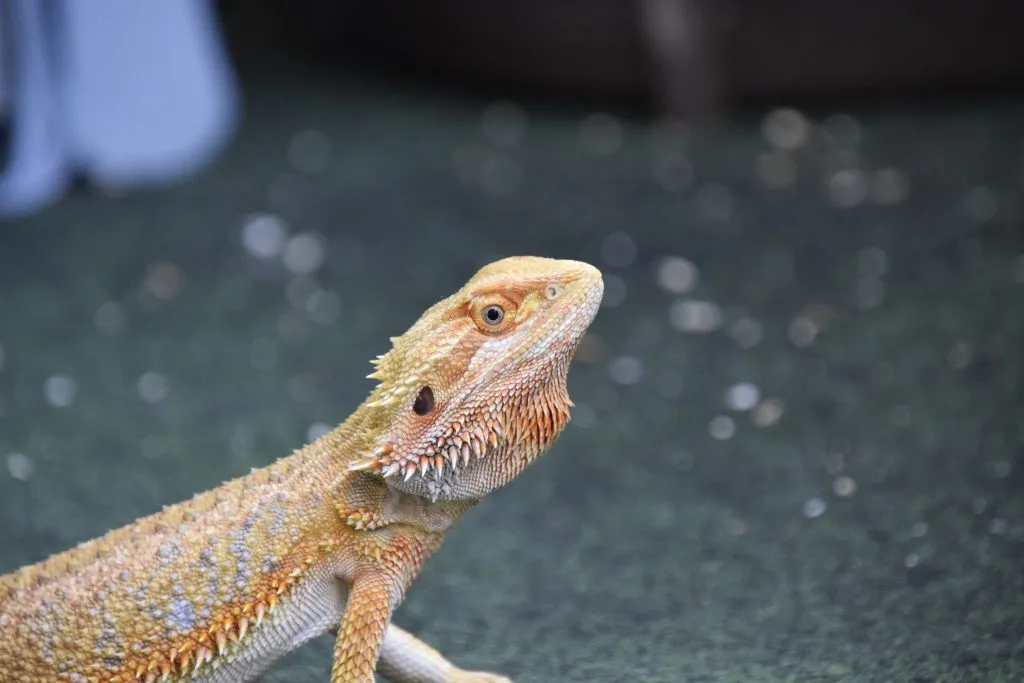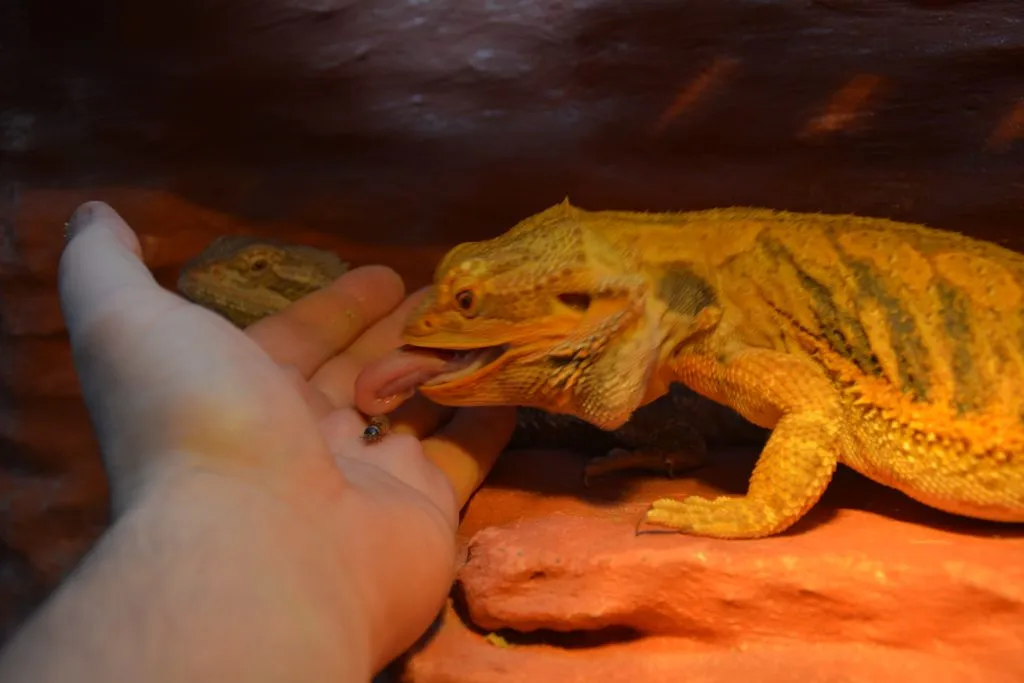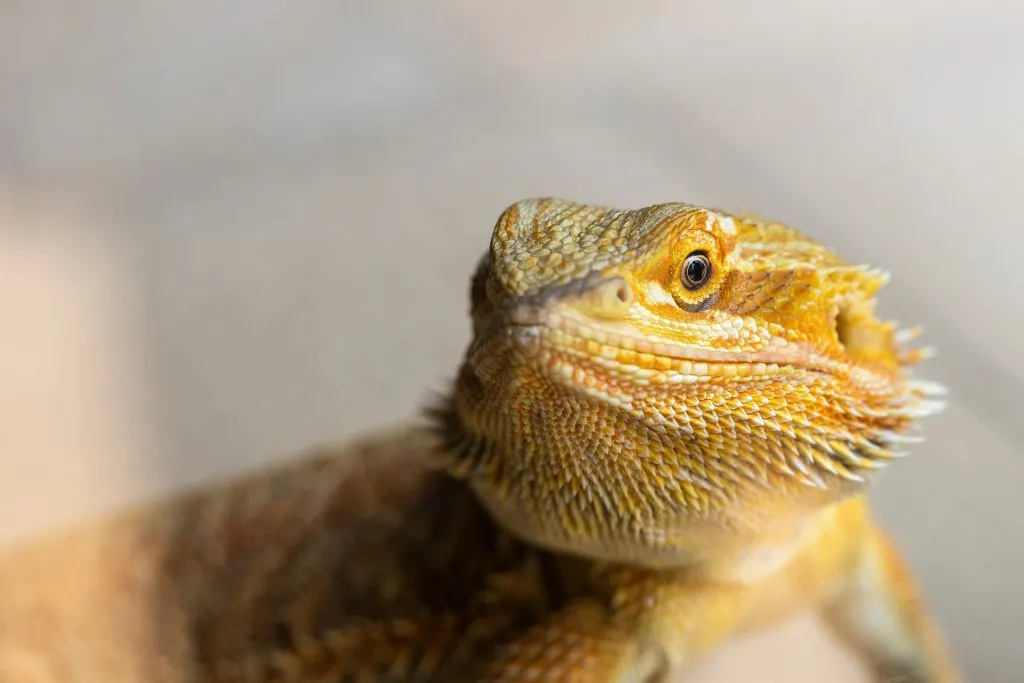
Why is my bearded dragon not eating? That’s a common query among dragon parents because though these reptiles are hardy, they can go off their
Generally, bearded dragons can stop eating due to illness, injury, low temperatures and other environmental concerns, and stress. Other factors for inappetence include shedding, brumation, incorrect diet, and an improper feeding schedule.
If you’re a dragon owner looking for ways to get your reptile to eat again, you’re in the right place. In this article, we will discuss why your bearded dragon may not eat and provide tips for tackling the situation.
Table of Contents
14 Reasons Why Your Bearded Dragon Is Off Its Food
As stated earlier, several factors can be behind your bearded dragon’s lack of appetite. We’ve created a different heading for each reason to make for easier navigation for readers. There’s also a helpful infographic for folks short on time.
With those disclaimers out of the way, let’s get on with the rest of our guide!
1. Your Dragon Has Newly Arrived
Bringing home a dragon is undoubtedly exciting for owners, but the reptiles may take some time to get used to new surroundings. For all their gentleness, these lizards are very cautious.
That means your pet will likely hide under rock structures or other decorations until they’re confident their surroundings are safe. During this time, your scaly friend might also go off its
How to Tackle It
Experts recommend giving bearded dragons their space when they’re trying to acclimate to a new
Don’t be tempted to force your dragon to eat or accept your touch. This will only lead to your reptile getting anxious and make it more irritable.

2. Your Dragon Has a Full Tummy
It’s possible your bearded dragon isn’t interested in
Baby dragons require three to five feeding per day because they have a lot of growing up to do, which requires constant energy. Juveniles, on the other hand, can get by with three feedings.
Once the dragons hit the 12-month mark, they can get by with two feedings, depending on the diet you’re giving them. Reptile owners need to be aware of the growth pattern of their dragons and how this impacts their dietary intake.
How to Tackle It
If you’re not sure about the feeding timetable of your dragon, you can always consult experts. Your veterinarian is the perfect source of personalized information. Besides, if your reptile shows no signs of illness or injury, it’s best not to force them to eat more.
Overeating in bearded dragons can lead to health concerns like obesity. It can also be problematic for your lizard’s digestion, as overeating can lead to constipation. A
The easiest way to describe a
3. Your Dragon Is Bored
Bearded dragons may seem like placid creatures, but that doesn’t mean they don’t require excitement. Be it hunting or avoiding predators; there’s plenty of stimulus in the wild. In captivity, however, beardies need more than just
Bored reptiles are prone to depression. Symptoms like sleeping for extended periods, lethargy, staying in one spot, and lack of appetite are all linked to depression in this species.
If your dragon stays listless after adding toys and other appropriate diversions, you might want to consider changing up its diet.
How to Tackle It
A time-honored way of tempting bearded dragons to start eating again is adding live feeders to their diet. Beardies like the excitement that comes from hunting for their
However, it’s best to note that beardies are omnivores. That means they do best on a diet that includes plant and animal (insect) matter—the percentage of greens to live feeders for baby bearded dragons clocks in at 25 percent to 75 percent.
Conversely, the diet of an adult dragon should contain approximately 75 percent plant matter and 25 percent feeders. Adult reptiles don’t require as much protein as their younger counterparts, and a protein-heavy diet can result in indigestion or constipation.
4. Your Dragon Is Unable To Catch Its Food

As said earlier, beardies like hunting. Nonetheless, there are times when your reptile may be unable to catch its
This type of problem generally turns up with live feeders. For example, black crickets are pretty aggressive and can make bearded dragons work for their meal.
On the flip side, if your dragon is a baby or juvenile, ensuring the
How to Tackle It
If you suspect your reptile isn’t eating because the live feed is too fast, too aggressive, or too big, switch to better feeder options. For instance, brown crickets are less aggressive and easier to catch.
Dragon parents can also rely on small dubia roaches or mealworms for baby or juvenile dragons having trouble fitting their meal in their mouths.
5. Your Dragon Has Mouth Rot
Infectious stomatitis (or mouth rot) is a bacterial infection that affects the reptile’s jawbones and gums. However, if not caught in time, the disease can progress quickly and result in tooth decay, loss of teeth, intestinal damage, and in extreme cases, organ failure.
Stomatitis causes various symptoms—for example, discoloration of the dragon’s mouth from pink to yellow or grey. Bearded dragons can also develop sores or pus-filled abscesses in their mouths when suffering from the disease.
Swelling around the gums or the face is another indicator. Sometimes, the swelling around the mouth can get so bad that it affects your lizard’s ability to close its mouth. This is also why dragons don’t feel like eating because opening and closing the mouth becomes painful.
Discharge from the mouth is generally a symptom of advanced disease. This occurs when the pus-filled pockets in the dragon’s mouth pop, causing the fluid to run out of the oral cavity.
This type of discharge isn’t too difficult to detect and often causes your pet’s mouth to stink.
Excessive drooling is another symptom bearded dragons with stomatitis experience. You may be able to see saliva dripping from your reptile’s mouth when it develops excessive swelling that affects jaw and mouth functionality.
Tip: Learn more about mouth rot in bearded dragons, how to detect and treat it, in our article here on beardie mouth rot!
How to Tackle It
How to help your reptile overcome mouth rot will mainly depend on how advanced the disease is. As always, booking a vet’s appointment is the best and safest method of ensuring your dragon’s complete recovery.
Veterinarians can adopt a multi-pronged approach when dealing with mouth rot. This includes intravenous antibiotics or extravenous antiseptic solutions (to disinfect the affected area and stem the growth of bacteria).
Experienced dragon owners can rely on home remedies if they suspect their pet is coming down with stomatitis. This method typically involves povidone-iodine mixed with water to help clean and disinfect the affected regions of the oral cavity with a cotton swab.
6. Your Dragon Has Parasites

As hardy as bearded dragons are, they’re still surprisingly vulnerable to parasitic infections. These include microorganisms that live on the host (ectoparasites) and within the host’s body (endoparasites).
Some of the most common parasites found in beardies include pinworms, hookworms, and coccidia.
While ectoparasites are easier to detect, endoparasites can be tricky. However, classic symptoms can help lizard owners determine whether their pet is suffering from a parasitic infestation.
One such sign is inappetence. Research reveals ‘lack of appetite’ is the body’s response to fighting off the infection.
Since parasites tend to derive their nutrition from their host’s body, the immune system produces hormones to reduce hunger to starve the hidden attackers inside your lizard’s body.
Other sure-shot symptoms of parasites include loose stools. If your pet’s poop has turned watery or contains mucus or blood, it can indicate pathogens. Beardies can also appear lethargic, depressed, or irritable when suffering from parasitic infections.
How to Tackle It
Your vet can advise injectable or oral anti-parasitics based on the pathogen you’re dealing with. This will require a stool analysis of your dragon’s feces.
That’s one of the many reasons why consulting with your vet is the best option if you suspect your scaley friend has unwanted guests on or in its person.
For ectoparasites, treatment revolves around topical or injectable medicines. Paying attention to
7. Your Dragon Has a Respiratory Infection
Believe it or not, respiratory infections are pretty prevalent in the Pogona vitticeps species. This might seem a little confusing since beardies are native to arid regions and like their
Here’s the thing, dragons can develop lung infections when the moisture or temperature level of their enclosures isn’t what they need to be. Besides that, unhygienic
Symptoms of respiratory infections include lack of appetite, mucus discharge from the mouth, wheezing, beard turning black, and weight loss.
How to Tackle It
Vets generally rely on antibiotics to clear out lung infections. These can be oral, injections, or inhalants. How strong or mild the drug response should be is typically decided after identifying the bacteria. If fungi or parasites are also involved, the medications become more diverse.
If dragon owners suspect their pet is contracting a lung infection, booking a vet’s visit in time is important. The sooner the microorganisms behind the disease are identified, the sooner your pet can start its treatment.
Finally, it’s crucial for dragon parents to pay attention to the temperature, moisture, and hygiene concerns of their pets’ tanks. Excessive dampness in a dragon’s enclosures will lead to moisture build-up in the lizard’s lungs and promote bacteria growth inside the
8. Your Dragon Has Impaction

The term ‘impaction’ tends to confuse a lot of newbie dragon owners. The best way to understand what impaction is to think of it as an advanced or aggravated stage of constipation. The food your reptile ingests remains in its digestive tract instead of exiting the system via elimination.
Beardies may fall ill with impaction and lose their appetite for numerous reasons. For example, too much protein and insufficient fiber in a dragon’s diet can result in constipation.
External factors, such as cold
Whatever the reason for impaction, it shouldn’t be taken lightly. If your reptile goes too long without elimination, this can result in paralysis and/or toxicity from the extra waste.
Tip: If your bearded dragon is not pooping, you should act quickly and identify the reason for that. Our article on why beardies stop pooping will help you with that!
How to Tackle It
There are several ways dragon parents can combat and ward off impaction. One of the easiest methods is to draw a warm bath for your pet reptile.
However, keep in mind this method works best with mild constipation. If your dragon isn’t moving or its back legs appear paralyzed, take it to the vet immediately.
Soaking your dragon in warm water helps your reptile relax and soften the waste stuck in the digestive tract. Experts also recommend massaging the abdomen gently to help break the mass part and get it moving.
If the warm bath method doesn’t help your lizard, booking an appointment with the vet is the best option. Once at the doctor’s, your reptile may be x-rayed to discover impaction severity. Treatment at the vet can involve enemas, laxatives, or surgery, depending on your dragon’s condition.
9. Your Dragon Has Metabolic Bone Disease
Bearded dragon enthusiasts don’t overlook Metabolic Bone Disease (MBD) when their pet stops eating. MBD consists of several disorders that impact a reptile’s bone structure. MBD can lead to brittle bones and muscle/tissue damage if left unchecked.
One of the reasons beardies with MBD tend to go off their
The disease is generally brought by several causes, including calcium (or Vitamin D3 deficiency), inadequate UVB lighting, and a high intake of oxalates or phosphorus.
Early detection of MBD is crucial as it can help stop bone and muscle damage before the dragon becomes too weak. If put off for long, the disease, plus the inappetence it causes, can lead to a swift decline in a bearded dragon’s health.
Early disease symptoms include lethargy, lack of appetite, constipation, and stress. On the other hand, moderate to severe disease will manifest in signs such as swollen jaw or limbs, receded lower jaw, arched spine, bowed limbs, and bumps along the spine.
How to Tackle It
If you think your dragon is suffering from MBD, the first order of business is to contact your vet. The veterinarian will run several tests, such as blood work and x-rays, to discover the intensity of the disease.
Once that’s done, you’ll likely receive a comprehensive treatment plan involving diet and medications to help get your dragon back on track. In mild cases, vets generally rely on upping the reptile’s calcium intake via calcium-rich foods.
In the more severe cases, your vet might recommend vitamin D3 injections, specialized UVB lighting, oral calcium supplements, calcitonin injections, and diet changes.
10. Your Dragon Is Injured

If you’ve not had any luck discovering why your bearded dragon isn’t eating so far, your pet may be injured or in pain. Contrary to popular belief, injuries don’t always leave observable clues.
Add to that that there are countless ways your reptile can hurt itself without leaving its
Bearded dragons can scrape or cut their skin on rock structures, experience thermal burns due to inadequate lighting setups, and strain or hurt their limbs while trying to get climb decorations. The list of possible ways your dragon can get injured is endless.
The best way for concerned reptile parents to detect if their lizard is in pain is to conduct a visual observation first.
Look for signs such as your reptile limping or favoring one leg. Thankfully, burns, cuts, or scrapes are typically detected much easier than internal injuries.
If you cannot detect any injury visually, try taking your dragon out of its enclosure for an inspection. Be careful while doing this, and keep a keen eye on your lizard for any signs of pain as you lift them.
How to Tackle It
If you’re sure your reptile isn’t ill or bored, you can try and inspect your pet for injuries. However, this isn’t always easy for beginner-level reptile enthusiasts.
If you’re not confident handling your lizard when it’s feeling down or irritable, take it to the veterinarian for a quick checkup.
The vet will likely conduct a physical examination and may run x-ray tests to reach a diagnosis. The treatment prescribed will revolve around the nature of the injury.
For instance, treatment for muscle or bone injuries may require painkillers, whereas treating burns or injuries can include antibiotics, topical creams, soaks, etc.
11. Your Dragon Is Cold
Reptiles, such as bearded dragons, are ectotherms. That means they’re cold-blooded and rely on external heat sources to regulate their body temperature.
One of the biggest reasons heat plays a crucial role in keeping a dragon healthy in captivity is that many of its physiological functions depend on warmth.
If the temperature of the enclosure is too low (due to inadequate heating or lighting), this can lead to dragons becoming lethargic and going off
How to Tackle It
To ensure your bearded dragon is warm enough, provide a basking spot with a 95-105 °F temperature range. The rest of the enclosure should be slightly cooler, with a temperature range of 75-85 °F. You can use a heat lamp or ceramic heat emitter to provide heat.
Tip: We bought and tested various heat lamps and show you the best heat lamps for bearded dragons here!
In addition to temperature, you also need to make sure that your dragon has access to UVB light. This is important for their health and well-being, as it helps them produce vitamin D3 necessary for proper calcium absorption.
Tip: Need a UVB-light for your bearded dragon? We also tested various UVB-light and found that these UVB-bulbs are the best for beardies!
Without enough UVB light, your bearded dragon may develop metabolic bone disease, which can cause a loss of appetite. If your bearded dragon is not eating, promptly addressing the issue is important.
In addition to checking the temperature and UVB light, you should ensure that the enclosure is clean and that your bearded dragon has access to fresh water and
12. Your Dragon Is Shedding

Bearded dragons shed their skin as they grow. Shedding is a natural process that occurs periodically throughout their lives. However, that’s not to say shedding can’t be problematic regarding your pet’s health and appetite.
The shedding process can be an uncomfortable experience for beardies. It can cause them to lose their appetite as they focus on molting. During this time, dragons can become dehydrated, making their skin itchy and irritated.
This discomfort can cause your bearded dragon to avoid eating. Monitoring your bearded dragon’s eating habits during shedding is essential to ensure they get the necessary nutrients.
One of the most noticeable signs of a preeminent shed is that your pet’s skin will appear dull and opaque. You may also notice that the skin around their eyes becomes milky or gray. Shedding can also cause your bearded dragon to become more irritable than usual.
How to Tackle It
Warm water soaks can be tremendously helpful during dragon sheds. This makes your pet feel relaxed and helps lubricate the skin, making the shed easier. Experts also recommend providing lizards with a moist hide during sheds.
This is a small enclosure within their larger enclosure where you can place a damp cloth or moss. The added humidity will help loosen their skin and make shedding easier and less painful.
Moist hides are more practical than increasing the overall humidity of the
Finally, if you notice a patch of dry skin that refuses to come off despite soaks and added moisture, it’s best to take your pet to the veterinarian. Stuck skin can sometimes constrict blood flow and lead to severe consequences (loss of limb or toes).
13. Your Dragon Is About To Enter Brumation
One possible explanation for the lack of appetite in bearded dragons is brumation. Brumation is a natural process that is similar to hibernation in other animals.
The process is generally accidentally induced by newbie parents when they allow the temperature to drop below 75°F for a prolonged period. During this time, bearded dragons slow their metabolism and conserve energy. This can cause them to eat less or stop eating altogether.
How to Tackle It
If you suspect your bearded dragon is going through brumation, ensuring they have access to water and a warm basking spot is essential. You should also avoid handling them too much, as this can disrupt their natural sleep cycle.
However, if you’re concerned that there may be another reason for your bearded dragon’s lack of appetite, it’s always best to consult a veterinarian specializing in reptiles.
In addition to the tips mentioned above, you can also offer your bearded dragon a variety of foods to see if they show interest in any of them.
It’s important to remember that bearded dragons have individual
If your bearded dragon still isn’t eating after a few weeks, or if they’re displaying other concerning symptoms, such as lethargy or weight loss, you should make an appointment with a reptile veterinarian as soon as possible.
They’ll be able to diagnose any issues and properly recommend a course of treatment.
14. Your Dragon Is Stressed

Stress could be the culprit if your bearded dragon isn’t eating as much as it used to. Bearded dragons are sensitive creatures and can become stressed for various reasons.
Signs that your bearded dragon may be stressed include lack of appetite, lethargy, aggression, tail twitching, and glass surfing.
How to Tackle It
If you have noticed any of the above signs, reducing your bearded dragon’s stress levels is important. Here’s how.
Bearded dragons are sensitive to noise and movement. Placing their enclosure in a quiet area of your home where they won’t be disturbed is a good starting point. Additionally, dragons require specific temperatures and lighting to stay healthy.
Ensure their enclosure is set up correctly and that you provide the right amount of heat and light. Beardies can also become stressed if they are handled too roughly. When you are holding them, be gentle and avoid sudden movements.
If your bearded dragon’s stress levels do not improve with these tips, it may be time to consult a veterinarian. Remember, a stressed bearded dragon can quickly become a sick bearded dragon. By taking steps to reduce their stress levels, you can help keep them healthy and happy.
- Enchi Ball Python: A Unique and Stunning Morph of Python regius - March 27, 2025
- Emerald Tree Monitor: The Enigmatic Green Guardian of the Rainforest - March 26, 2025
- The Egyptian Cobra (Naja haje): A Fascinating Serpent - March 25, 2025
